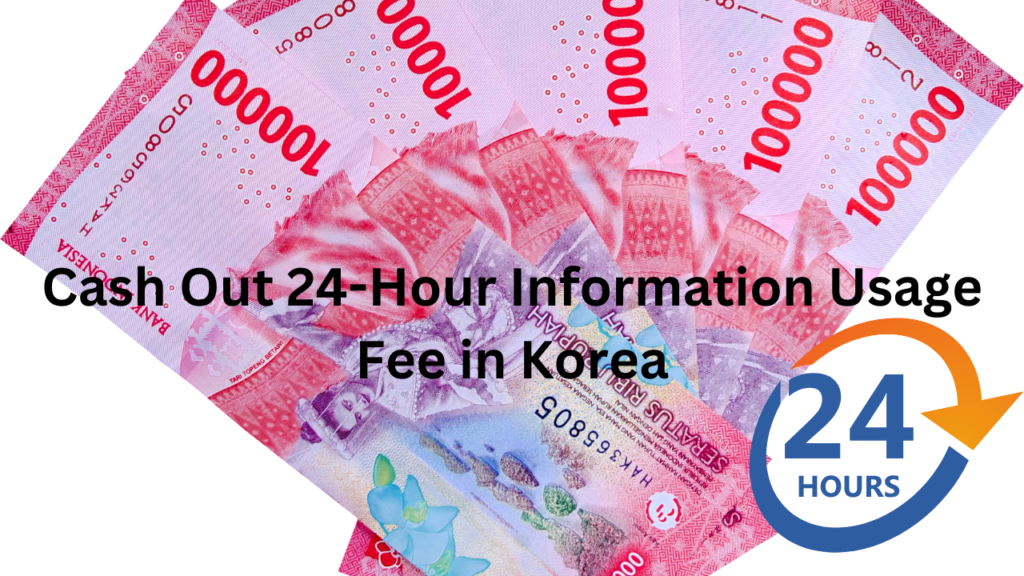In South Korea, the information economy has grown increasingly crucial, with technology and data at the centre of many daily activities. New business models and fee structures have evolved due to this digital surge. A good example is the “24-hour information usage fee”, which is a charge to the users for accessing specific data or services within 24 hours. This article will examine what Cash out 24-hour information usage fees in Korea are, their consequences, and how they affect consumers and businesses.
The Concept of Cash out 24-hour information usage fee
The user uses the 24-hour information usage fee as a payment model for accessing particular digital content, data, or services within a day. This fee system is used in various industries, such as the telecommunication sector, online gaming industry, and streaming service providers, among other forms of digital platforms. The idea behind this concept is quite simple: people need to pay a certain cost to get access to some specific information or services for only 24 hours. After that, they should either renew it or lose access.
Applications of the Cash out 24-hour information usage fee
The 24-hour information usage fee has been implemented across different sectors in Korea. Some examples among many are:
Telecommunications: Mobile operators may have 24-hour data plans that allow users to browse unlimitedly or have particular premium services for a day, which is especially helpful for tourists or those needing short-term access without commitment.
Online Gaming: Some popular online games offer temporary access to unique content or events through a 24-hour fee. Players can pay for a single day and get exclusive items, challenges, and events.
Streaming Services: In Korea, streaming sites may offer movies, shows, or music playlists accessible for one day. This one-time access can be cost-effective for users who need specific content temporarily.
Pros and Cons of the 24-Hour Information Usage Fee
The advantages and disadvantages of Cash out 24-hour information usage fees for both consumers and businesses are outlined below. This information helps stakeholders make informed decisions.
Benefits for Customers
Flexibility: Compared to permanent subscriptions, the 24-hour payment plan offers customers more flexible payment periods.
Cost-effective: For occasional users, this fee structure can be more economical than monthly or yearly subscriptions, allowing them to access high-quality services without long-term commitments.
Trial Period: The 24-hour access serves as a trial period for new users, enabling them to test the service before committing to a longer-term arrangement.
Challenges for Consumers
Recurring Costs: For frequent users, the cost of using information for 24 hours can become more expensive than a long-term subscription.
A 24-hour access fee has some drawbacks. Once the day ends, you have to start over again.
It might not work well if you lose internet access during the day. People with poor connections may not get full use.
Impact on Businesses
The 24-hour fee sounds suitable for making money. But it also faces several challenges.
Benefits for Businesses
It brings in extra money. It targets users who don’t want long subscriptions.
More people may try short plans to test a service before committing, which could boost engagement and brand attachment.
Companies can offer different 24-hour packages at varying levels of access.
Challenges for Businesses
The 24-hour fee is short-term. It may hurt customer retention and loyalty.
It increases competition as users can easily switch providers for short access.
Managing 24-hour access requires complex systems for access, billing, and support, which adds operational complexity.
Conclusion
In South Korea, 24시간 정보이용료 현금화 is a fresh idea. People pay for online stuff they want for 24 hours only and gives choice and value. But it also makes repeat costs for users. And businesses must work to keep paying customers. To keep this pay model working, companies must adjust to new tech trends and what people want. Rules from the government matter, too. All sides need to sort out these bumps in the road. If not, affordable digital access for the public will be hard.

